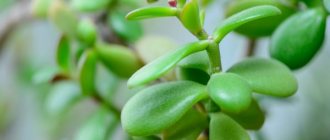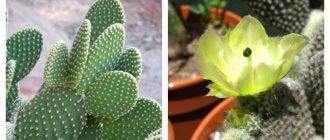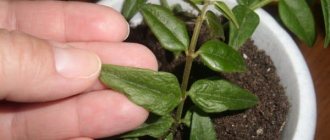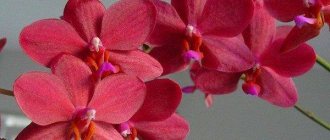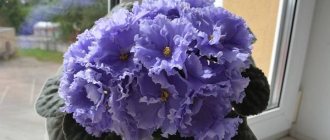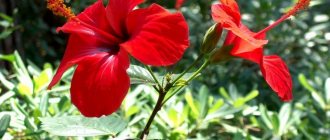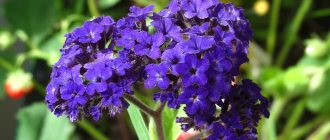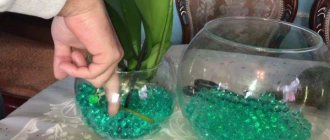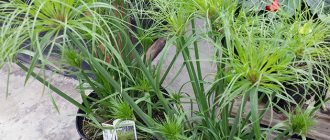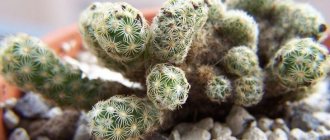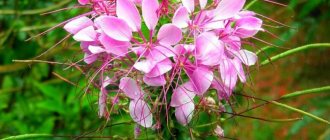Characteristic
Crassula minor is an artificially bred variety that is a variety of Crassula ovata. The leaves of the plant are quite small - no more than 1.5 centimeters in length and 1 centimeter in width. They have an oblong shape. The coloring is very interesting, which allows it to complement any garden compositions with Crassula - the edges of the leaf above and below are framed in red, and the middle of the leaf is dark green. Depending on the lighting, the indoor plant changes its shade.
The trunk of young Crassula minor is green, fleshy and soft. Over time, when the lower leaves die, it becomes bare and woody. This property of the plant allows it to form miniature trees as it grows.
Types of Crassula with photos and names
As mentioned above, there are a very large number of species of Crassula. Below we will give a description of those species that are most popular among gardeners. Representatives of tree-like crassulas, called “money trees”:
Crassula oval (Crassula ovata), or ovoid
This type is most popular among gardeners. Its homeland is southwestern Africa. In nature, the height of the bush can reach 300 cm, but when grown at home it does not exceed 150 cm. The oval glossy leaf plates are painted green or gray-silver. This plant is fast growing and produces a large number of shoots. The apical umbrellas consist of small pink or white flowers. This species is distinguished by the greatest shade tolerance from all others, which is very important when cultivating at home. Breeders use this species as the main one for breeding a large number of varieties, which are very simple and easy to grow even for novice gardeners. For example:
- Crassula Minor is a compact form of Crassula ovoid, the “Crosbys Compact” variety stands out especially, its pale red leaf plates reach up to 15 mm in length and up to 10 mm in width, this variety is good for mini-gardens;
- Crassula Hobbit and Crassula Gollum - these 2 American hybrids of Crassula milk and Crassula ovoid are very similar to each other, they have an unusual shape of leaf plates that seem to be turned outward, which are fused from the base to the middle - in the Hobbit, and are rolled into tubes, expanding funnel-shaped to the tips Gollum's leaves;
- Crassula Sunset - this tricolor cultivar has foliage, the surface of which is decorated with stripes of yellow or white, and it also has a red edge.
Crassula arborescens
This species is similar to Crassula ovate. Its trunk and branches are bare, the shape of the flat fleshy leaf plates is round-obovate, they have a grayish color with a pale blue tint and a red border along the edge, their length can vary from 35 to 70 mm. Paniculate inflorescences consist of white or pinkish flowers, however, when grown indoors, flowering in such a plant is very rare. In order for this species to grow and develop well, it needs bright sunlight, but it does not like shade. The following varieties are cultivated by flower growers:
- Crassula undulatifolia - flat narrow foliage of a bluish-silver color with red tips, there is also a variegated form;
- Crassula curly - with wavy large leaf plates.
Crassula portulacea, or silvery
Externally, this species is very similar to Crassula tree and oval, but it is more compact in size.
The most popular among gardeners are the following creeping Crassulas:
Crassula lycopodioides or Crassula muscosa
This shrub plant is compact; it reaches a height of no more than 25 centimeters. The creeping fleshy stems have a tetrahedral shape and curled tops. In terms of the placement and structure of the leaf plates, this species is very similar to the clubmoss. It is undemanding and grows well in shade, and in bright sunlight its foliage becomes slightly reddish.
Crassula pseudolycopodioides
The stems of this species are more curved, and they are not very pressed against the shoots. There are forms whose foliage is silver, yellow or variegated.
Crassula lactea, or milky (Crassula lactea)
This large hanging plant has a stem length of about 0.3 m. The greenish-gray leaf blades, rounded and pointed at the tips, are 30–40 mm long and 20–30 mm wide.
Crassula picturata
This type is highly decorative. On the lodging branching stems there are leaves that have an unusual color: on the green surface there are many red dots, on the underside of the plate they look purple. There are transparent cilia on the edge of the foliage.
In addition to these creeping species, flower growers also grow Crassula Cooper and tetrahedral.
In culture, the most popular columnar crassulas are:
Crassula perforata, or perforated (Crassula perforata)
The small bush is decorated with diamond-shaped foliage, which covers the shoot as if it were strung on it. The color of the foliage is greenish with a touch of bluish color, and along the edge there is a gristly red border.
Crassula Buddha
This hybrid of Crassula perfoliata and Crassula pyramidalis is more correctly called Crassula “Buddha's Temple”. Such a bush is similar in appearance to columns, which consist of tightly pressed triangular-shaped leaf plates strung on a shoot and dark green in color. Once the height of such a “column” exceeds 15 centimeters, it is capable of collapsing on its side under its own weight. Short apical inflorescences consist of red flowers.
Even in indoor conditions, the following species are cultivated: Crassula marginal (or bordered), spatulate, rocky, rounded, offspring, rosette, crescent-shaped, grouped, pierced-leaved, woolly, Schmidt, etc. In specialized stores, in some cases you can find a plant called "Crassula mix" In this case, it must be taken into account that this is not the name of the form or variety, but simply the marking of a batch of Crassula, which means that it consisted of various species and varieties.
Common types and varieties of Crassula! Varieties of the Money Tree!
Home care
It is impossible to grow a healthy and beautiful “money tree”, which, according to many popular beliefs, attracts financial well-being into the house without proper care for it. These are simple steps that will not take much time, but will provide the plant with the necessary nutrients and create comfortable conditions for growth.
First you need to choose the right crassula minor in the store. The health of the plant is indicated by its appearance. The leaves should be elastic, without spots and rough plaques, without damage by insects and parasites. The trunk is elastic, without flaccid areas and depressions.
Landing
After purchasing Crassula minor, it should be replanted in suitable soil. Usually they take ready-made soil for cacti or prepare the substrate themselves: 1 part peat, leaf and turf soil and 0.5 part sand. The soil must be well drained; for this, small broken bricks or charcoal are added to the pot.
The choice of the pot itself depends on the diameter of the plant crown. Crassulas prefer shallow but wide containers; their root system is small and does not need space.
The usual transplantation of Crassula minor is carried out annually in the spring using the transshipment method, preserving a piece of earthen coma at the roots.
Watering
Crassula needs specific watering. Excessive fluid intake can lead to the death of the “money tree”. The soil should be moistened only when it has dried to a depth of more than 3 centimeters.
From spring to late autumn, Crassula minor is watered once every 1-2 weeks , as soon as the soil needs it. In winter, when the plant is moved to a cool room, it needs to moisten the soil mixture only once a month.
You should not allow the earthen clod to dry out, so that the Crassula roots are not damaged. If the plant does not have enough moisture, this immediately becomes noticeable by the darkened leaves, which wrinkle and cease to shine.
Excessive moisture threatens rotting of the root system and stem.
Pruning and crown formation
Crassula minor is easy to form a crown. This allows you to make it a real decoration for your home mini-kindergarten. As soon as 3-4 pairs of leaves grow on a branch, the next bud that hatches is pinched off. At this point, 3-4 buds will again form, and the plant will begin to branch in different directions.
Long branches of the Crassula can be pruned. To do this, use a sharp knife or blade, and the cut area must be sprinkled with charcoal or crushed activated carbon.
Purchase and adaptation
The flower is replanted every three years
The purchased plant is quarantined for 20 days. During this time, you will be able to determine whether it has parasites or an infection.
It is replanted using the method of transferring an earthen clod. This procedure is mandatory, because Crassula will grow and develop poorly in purchased land.
Use a clay pot with drainage holes at the bottom.
The root system is superficial and branched, so the flowerpot should not be too deep, but wide. The diameter is 2-3 cm larger than the previous container.
Transplant technology:
- The bottom is sprinkled with expanded clay.
- Fill ½ of the volume with a nutrient composition of peat, turf, leaf soil, humus and sand, mixed in equal quantities.
- Turn over the root ball, add soil to the top, and water it.
- For quick adaptation, stable heat within 20-23° and good lighting without direct sunlight are required.
The plant should be replanted every 2-3 years. You can tell when the time has come by looking at the roots - they are pushing through the drainage holes.
Unscheduled transplantation is necessary for specimens with damaged or rotten roots.
Reproduction methods
Crassulas propagate by cuttings and leaves. These are the simplest methods that guarantee rooting and further growth of the plant.
The krasula leaf is torn off and placed in water for a day. Then it is transferred to a pot and covered with earth. Watering abundantly.
Propagation by cuttings is no less simple. The cuttings are separated from the plant, dried for 1-2 days and placed in a mixture of soil and sand or in a prepared mixture for cacti. The first watering is carried out after 3 days, allowing the plant to adapt a little. The next moistening of the soil is carried out as it dries.
Varieties of Crassula Ovata
1. Species Crassula Ovata The Hobbit is very large in its natural population. Absolutely unpretentious to conditions, because of its shape it looks like an independent bonsai. The variety was bred from Crassula oval, which greatly affected its appearance. The leaves are oblong and have a shallow hole at the end. Despite its evergreen color, it can change if kept in full sunlight. The color scheme reaches crimson. The maximum height is about two meters in the wild, but at home it hardly reaches one meter. Blooms less than once a year.
Krasulla Ovata The Hobbit
2. Crassula Ovata Gollum is noticeably different from the previous variety in its leaf shape. The shape of the leaves is quite dense, they look like elongated halves of tubes. It does not require the creation of certain climatic conditions at all. It can reach a maximum height of half a meter, which is associated with a very long growth of stems.
Crassula Ovata Gollum
3. Crassula Ovata Minor. The variety was bred artificially. A typical representative of the family of tree-like plants. Can survive without watering for about one month. In indoor conditions it can live for about 50 years. This is the same flower whose leaves are compared to small coins. When near a source of natural light, the foliage may turn red. Ideal for creating a bonsai garden indoors.
Crassula Ovata Minor
4. Crassula Ovata Sunset. It is similar in shape to its predecessor, Crassula Minor, but stands out noticeably for its unusual shade of leaves. They take on a yellow-pink color. It begins to bloom at the age of seven or eight years, when it reaches maturity. It needs feeding most from April to August.
Krasulla Ovata Sunset
Diseases and pests
Crassula minor is susceptible to parasitic diseases. Its leaves are often attacked by scale insects, spider mites, aphids, and the root system is attacked by root and mealybugs, and fungus. Signs of the disease can be not only visual insects and their metabolic products on the surface of the crown, but also lethargy, rotting, and spots on the foliage.
Insecticides sold in stores will help get rid of pests. Their chemical composition is destructive to pests, but safe for the plant.
It is much more difficult to get rid of a fungus that has affected the root system. The reason for its appearance and spread may be excessive watering with cold water straight from the tap. If fungal damage is detected, the fat plant should be pulled out of the pot, the roots freed from the earthen ball, washed, treated with special antifungal agents and replanted in a new soil mixture.
Crassula minor requires human help for proper development and growth. This miniature and original plant will be a bright addition to the garden of “living stones” of succulents or will delight the eye as a single formed tree.
Description and features
The homeland of Crassula Ovata is South Africa, which already has more than 350 varietal species. Species diversity depends on the places in which Crassula grows. In drier conditions, unusual leaf colors and shapes stand out. Among all this diversity, there are both dwarf subtypes and powerful trees that stretch their trunk high into the sky.
The only thing that remains unchanged in a large natural assortment is the opposite leaf arrangement, the thickness of the leaves and the absence of cuts in the leaf plates. You should know that the leaves of Crassula Ovata are unsuitable for food because they contain a large amount of arsenic, which negatively affects the health of people and their pets.
Blooming Crasulla Ovata
Surprisingly, the number of pistils corresponds to the number of stamens. The flowers are quite small and collected in small bunches. Most species fit into three conditional groups:
- Tree-like - reaches a height of up to one meter. It stands out for its color on the underside of the leaves. It is characteristically red. Over time, the trunk curls and acquires a characteristic brown tint. The species actively blooms in autumn-winter. The flowers are white.
- Creeping - distinguished by their speed of covering the grass area. Its shape is very different from its predecessor, from the elongated club mosses to the thin yellow leaves of Crassula Otpryskova. It is grown mainly in summer cottages to reduce air humidity.
- Spike-shaped - have a straight stem that can reach only half a meter. The shape of the leaves is very amazing, they seem to be strung on top of each other. In terms of color, it can be either a green plant or with brown spots.
In addition to the main subspecies, there is a wide variety of different varieties that are unique in nature. It is worth considering more significant species that can be observed in the homes of most indoor plant lovers.
Photo
We invite you to get acquainted with other types of this beautiful and easy-to-care plant. Read about the Tree Crassula, Purslane, Sunset, Silver, Lycopod, Perforata, Buddha Temple, as well as The Hobbit and Gollum.
Price of plant and seeds
The price range of plants in pots varies greatly. Let's say the price of Crassula Sunset and Gollum does not go beyond 1.5 thousand rubles, while the Hobbit costs about 5-6 thousand. Crassula Minor is usually slightly cheaper than its relatives. This is due to the prevalence of the variety.
Leaf cuttings are quite cheap, their price varies from 50 to 400 rubles. They can be freely ordered both in online stores and from hand, having found similar advertisements.
Plant seeds do not go beyond standard prices; they can be freely purchased in specialized stores, along with accompanying equipment for planting and growing.
Crassula Ovata is truly a wonderful plant that has an attractive beauty. The sight of its stems can amaze every lover of indoor floristry. Among the advantages, unpretentiousness to climatic conditions and a small amount of moisture consumed immediately stand out. But like any other plant, the varieties of this plant need to be looked after.
Proper care, practical treatment and replacement of drainage will allow the plant to please the eye for a very long time. If you really want, you can start starting a pocket bonsai garden at home, which is so revered in Asian countries.
Unfortunately, most Crassula varieties are already beginning to disappear due to poor ecology. It must be remembered that by keeping indoor flowers in favorable conditions, people continue to cultivate and save many natural species with their own hands.
What are the benefits of Crassula?
According to experts in the field of naturopathic medicine, the plant has medicinal properties. The scope is quite wide:
- The pulp from the leaves is used to treat burns, wounds and ulcers.
- The juice is effective in treating herpes.
- Lotions are used to relieve pain caused by arthritis.
- In combination with petroleum jelly, the leaf juice is used to treat hemorrhoids and varicose veins.
- Water infusion and alcohol tincture treat various diseases of the kidneys and gastrointestinal tract.
Important! Do not self-medicate. There is a risk of poisoning as it has been proven to contain arsenic among its chemical components.
Often plagued by pests
Mealybugs
Treatment
You can get rid of them manually using an alcohol swab . Afterwards they begin processing with “ Fitoverm ”.
Root scale insects
When it appears in the ground, the plant stops growing, the roots are damaged , the above-ground part looks depressed and faded .
Treatment
To get rid of root worms, the rot is cut off and the roots are treated with “ Acaricide .” Then the flower is planted in another pot, replacing the soil.
Shchitovka
A pest with oblong body is easy to notice .
Treatment
The flower is treated by spraying with Actellik . Repeated treatment takes place after 10-14 days to kill the larvae.
Spider mite
The pest loves dry conditions , so it often settles on cacti and succulents .
Crassula ovata (lat. Crassula ovata) - what it looks like
Crassulaceae ovata, as it is also called, belongs to the Crassulaceae family. The herbaceous succulent originates from South Africa, where it is found in dry, rocky areas. Today it is a very famous garden and indoor plant that can decorate any home.
Crassula ovata
In its natural environment, the Crassula succulent can grow up to 180 cm in height. As they age, the stems of this shrub become woody and turn brown.
Numerous leaves are ovoid, thick and juicy, never have cuts, painted in different shades of green, with a reddish border.
For reference! The heat-loving plant can withstand a short drop in temperature even to 0 °C.
Crassula ovata varieties popular in indoor floriculture:
- Crassula Lactea is a creeping (ampeloid) subshrub with shoots up to 60 cm long. The stems are brownish in color, and the leaves are light green with white dots along the edges, which are salt crystals;
- Variegated - Crassula with light green leaves covered with chaotic spots and stripes of lighter or darker color. The border around the edge of the foliage may be red or yellow;
- Treelike (lat. Crassula Arborescens) - its green leaves (up to 5 cm wide and up to 7 cm long) have an almost regular round shape with a bluish tint and a reddish underside. Needs very bright light and very little watering;
- Crassula Horntree is an oval variety whose young shoots are pink and then turn brown. The leaf is initially oval, and then grows together in half, turning into a tube. The tips of the leaves may be red;
- Tricolor - Crassula, which has a light green leaf covered with white stripes and a red border along the edge;
- Mix is a small-leaved variety of succulent (leaf up to 4 cm long and up to 2 cm wide), easily forms a tree when pinched correctly;
Crassula - a flower ideal for bonsai
- Hobbit is a compact species up to 60 cm tall with elongated funnel-shaped leaves. In bright light, the crown turns yellow and a reddish border appears along the edge of the leaves;
- Minor is the smallest-leaved variety, the leaf width is up to 1 cm, and the length is up to 1.5 cm. The dark green leaf in bright light acquires a reddish narrow border;
- Moss-shaped - on its straight stems in 4 rows there are scale-like triangular-oval leaves of green or yellowish color, sometimes with a reddish border. Erect shoots up to 25 cm long lie down over time and easily self-root;
- Convolute - distinguished by a darker color of the leaves, which gradually grow together, curling into tubes. In bright light, the edges of the leaves turn burgundy.
Crassula Horn Tree
Briefly about the history of appearance
In Europe, the succulent appeared at a time when the colonization of South Africa (Zimbabwe, Madagascar, Mozambique) was taking place. From there they brought trees with thick leaves that looked like coins.
Since they required practically no care, and rumor cemented the plant’s reputation as a “tree of luck,” its popularity only grew every year.
Useful properties of Crassula
Thanks to the substances secreted by the leaves, Crassula is able to disinfect the air in the room in which it is located. The antiviral effect of its juice allows it to be used as a folk remedy. It is used to make lotions after wasp and bee stings, as well as bandages for various wounds and bruises. For arthritis, rubs are made using Crassula juice, and solutions are also prepared from it for gargling in case of inflammatory processes in the throat and gums. But it is necessary to ensure that such juice does not get inside - despite the abundance of beneficial properties, it contains quite high concentrations of arsenic.
The fat woman is also well known in folk superstitions. This plant is supposed to bring wealth and good luck to the home. Together with the coin-shaped leaves, this belief gave the plant another name: the money tree or the tree of happiness. Thanks to this reputation, as well as its low maintenance requirements, the fat plant is often found in offices, shops and business centers.
Varieties of Crassula Lycopodioides and their photos
Pseudolycopodioides (Pseudolycopodioides)
Crassula lycopodioides is a variety of Crassula lycopodioides, in which the stems are more curved and the leaves do not cover the shoots so tightly. Therefore, the stems resemble a more voluminous braid. The leaves are either green or yellowish or silvery. The color can even combine several shades at once. The stems, in comparison with the lycophyte, tend to move more in different directions, and not just straight up.
Cristata
Cristate forms of succulents are associated with a mutation in the growing point. It does not grow upward, but divides in width. The plant takes on the shape of a ridge. Thus, the shoots of Crassula of the lycopod-shaped cristate form become flat and wide in the upper part, as if in the form of an inverted triangle. Cristata has a very exotic appearance and is of interest to collectors.
Monstrosa (Monstrosa)
The monstrous form of Crassula does not have an attractive appearance. Monstrousness is a mutation when a succulent grows with several growth points at once. Such a plant is characterized by a disharmonious appearance: breaks on the stems, random branching. The arrangement of the leaves may be radically different from the normal form.
Variegata
The variegated form of the plant is also formed as a result of mutation. In such specimens, some cells are unable to synthesize chlorophyll. Therefore, the leaves of the variegated Crassula are colored with inclusions of yellow, beige, reddish, and pink shades. Decorative and beautiful!
Fragilis (Fragilis)
This is the smallest variety of Crassula from the group of lycophytes. The plant reaches a maximum height of 10 cm. Fragilis has thin stems. The leaves are spherical and arranged in pairs.
Purpusii (Purpusa)
This variety has fleshy, triangular leaves that grow at an angle to the stem rather than being tightly attached to it. A very decorative compact plant.
Description of the genus of succulent Anacampseros
Dracaena sandera: description of the plant, features of reproduction and care at home
Succulents of the genus Anacampseros are crops whose natural habitat is the territory of South Africa. The name “Anakampseros” itself literally translates as “the plant that brings back lost love”; it was previously used as a talisman to regain the sympathy of a loved one. Previously belonged to the Portulacaceae family. Since 2009, this genus belongs to the newly created family Anacampserotaceae.
Anacampseros plant in natural habitat
Representatives of this genus have original roots of the surface type; some species may have a turnip-like root system. The shoots of succulents are thickened, they are short, sometimes erect or lodging. Some plant species grow up to 61 cm in height.
The leaves are usually large in shape, they are both long and quite thick. They are colored green, but can also be purple and speckled. It is interesting that the leaves are found both in one color and with a mix of several shades. Each leaf may partially enclose a stipule of a fleecy or hidden type. Different types of succulent have different shapes and colors of leaves and flowers.
The flowers of the succulent are white, pink, and red and have 5 petals. They are located singly or in brushes. Flowers can bloom in hot weather, but there are varieties that can only bloom at night. The period when the bush blooms usually falls in May, summer months or September.

